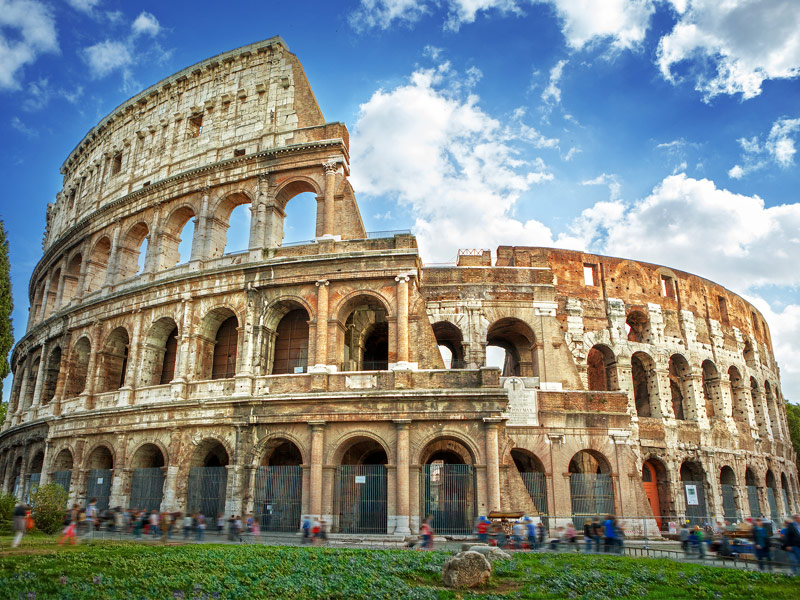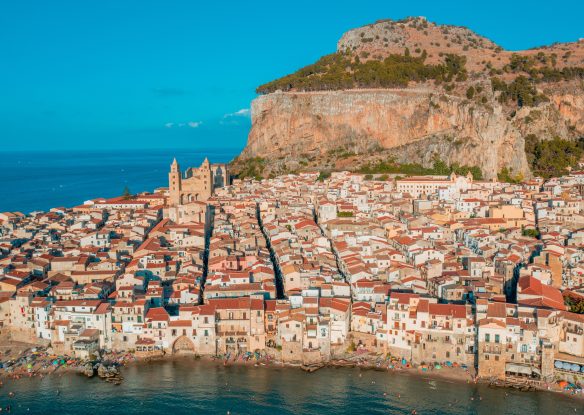Originally built back in 27 BC, the Roman Pantheon is the most preserved and influential building from ancient Rome. Remarkably intact, this temple dedicated to the gods was rebuilt in the 2nd century AD following fire damage, and following the Renaissance period, it became the designated tomb for some of the city’s renowned artists and elite, including the famous painter Raphael and former kings of Italy. It’s a must-see for anyone visiting Rome, along with many other sites that can be reached within walking distance.

Roman Colosseum
Rome’s most famous classical ruin is about a 20-minute walk from the Pantheon. The Roman Colosseum, half circus, half sports area, was inaugurated in the 1st century AD. Seating over 50,000 people into its neatly arranged stands, it started the tradition of fights between men and beasts. A gory, brutal place, some 5,000 creatures were killed in the opening event alone. The last man vs. beast battle took place in 523 AD, and by then, the wild animal population in North Africa had been decimated. Human on human combat also occurred, using gladiators captured and then trained in special schools to fight each other to the death.

Trevi Fountain
One of the most beloved attractions in all of Rome is a massive Baroque flurry where water flows from rocks under the feet of Neptune, Triton and seahorses into a large pool, called the Trevi Fountain. Located just a 5-minute walk from the Pantheon, it’s always surrounded by coin tossing tourists. There are multiple reasons for throwing three coins into the fountain, as it is said to bring benefits, primarily the chance to return to the city to find true love. Around $3,500 is thrown into the fountain every day, but it all goes to a good cause, collected and used to support food programs for Rome’s poor.

Roman Forum
The Forum was the center of life in ancient Rome, located near the Colosseum. It played host to celebrations and festivals as well as funerals and rituals. Today it hosts a mix of triumphal arches, temple ruins and marble fragments as well as other ancient architectural elements from various time periods. Pick up a map at the visitor center to take a self-guided tour to understand what you’re viewing. Evidence of human activities from as early as the 10th century BC have been found where the Forum stands, though the first temples and public buildings were raised here by the 6th century BC. It continued to be the center of life in Rome for well over a millennium.

The Spanish Steps
Less than a 15-minute walk from the Pantheon you’ll find the Spanish Steps, one of the longest and widest staircases in Europe, leading from the Piazza di Spagna up to the Trinita Church. A Barcaccia fountain bubbles at the foot of the steps, while the church rises above the crowds at the spot. Built between 1723 and 1725 in Roman Baroque style in an elegant series of ramps with 138 steps in a fan or butterfly wing shape, if you walk them in May, the ramps will be covered with colorful spring flowers. A popular tourist attraction, this is also an ideal place for people watching.
Galleria Borghese
It’s worth the 30-minute walk to visit Galleria Borghese, located in a vast garden-filled park. The grand building is just as impressive on the inside as it is on the outside. Housing one of the world’s great art collections, it showcases Bernini’s sculpture Apollo and Daphne as well as Titian’s Sacred and Profane Love and impressive works by master artists like Raphael, Correggio and Rubens. Just outside the villa are a series of secret gardens and a beautiful 17th-century aviary.
Vatican City and Its Massive Art Collectoin
Although the Vatican City is within the city of Rome, it’s an independent state with its own militia to protect the Pope, along with 800 full-time citizens and visiting residents. It even has its own coins, flag and stamps. A half-hour from the Pantheon, you could easily spend a full day exploring the area, including the Vatican Museums, a vast complex of galleries and museums that showcase spectacular sculptures, frescoes, paintings, classical antiquities and tapestries. It’s also home to Michelangelo’s Sistine Chapel, a place everyone should see at least one in their lifetime. Other highlights include the Raphael Rooms and St. Peter’s Basilica. In a spot known for its beautiful churches, none can hold a candle to St. Peter’s, the largest, richest and most stunning basilica in the entire country.

Galleria Alberto Sordi
Only a 5-minute walk from the Pantheon, Galleria Alberto Sordi is a shopper’s delight, offering the chance to shop while admiring stunning beauty, that includes stained-glass skylights and mosaic floors. Dating back to 1922, it’s considered the last architectural portrayal of Rome in the early part of the 20th century.





































